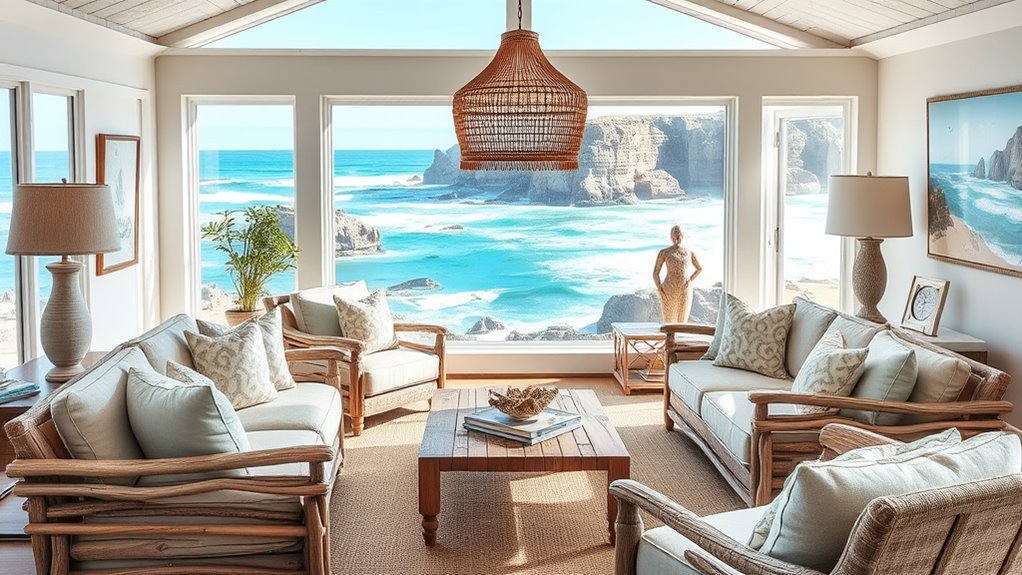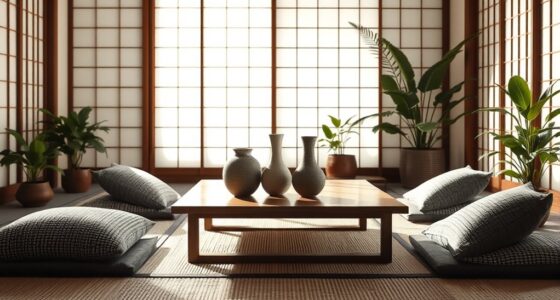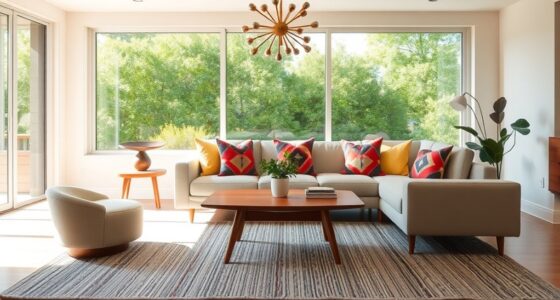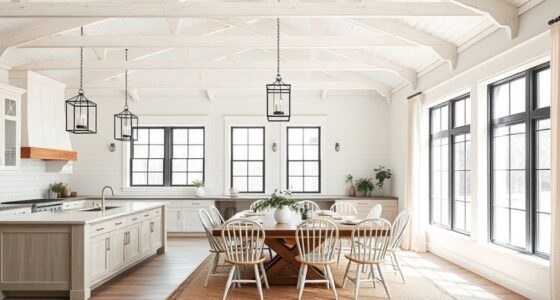Coastal décor goes far beyond just beachy blues by blending a rich mix of colors, textures, and design elements that create a more sophisticated and versatile seaside vibe. Think layered fabrics, natural materials like rattan and driftwood, and nautical accents that add depth and authenticity. The focus on light, openness, and regional influences helps craft an inviting, relaxed atmosphere. If you explore further, you’ll discover how these elements come together to elevate your space well beyond simple beach-inspired hues.
Key Takeaways
- Coastal decor combines a calming palette of blues with natural textures and materials for a layered, authentic seaside ambiance.
- It incorporates nautical elements like driftwood, seashells, and rope to add visual interest beyond just color.
- Emphasis on natural light, open layouts, and outdoor connections creates a spacious, airy environment.
- Pattern mixing and textured textiles enhance depth, complexity, and a relaxed, sophisticated vibe.
- Thoughtful accessories and sustainable materials reinforce the coastal aesthetic’s warmth and tactile richness.
The Versatility of Color Palettes in Coastal Design

Coastal design thrives on the versatility of its color palettes, allowing you to create a range of moods and styles with ease. Blue is the foundation, from soft sky and pale aqua to deep navy and moody grey-blues, offering endless options for your space. Pair these coastal colors with neutral shades like whites, beiges, and light greys to strike a perfect balance between subtlety and boldness. Layering different blue hues with varying saturations adds depth and dimension, making your interior feel dynamic and personalized. This approach also allows you to blend colors seamlessly, whether you prefer a modern minimalist vibe or a rustic charm. Incorporating layered color schemes can enhance the overall aesthetic and create visual interest. Understanding the contrast ratio in your color choices can further elevate your design by emphasizing certain elements and creating focal points. Additionally, experimenting with different saturation levels can help you achieve a more nuanced and sophisticated look. Exploring vibrational harmony in your color selections can also contribute to a more balanced and inviting atmosphere. With thoughtful layering and tonal variations, your coastal decor becomes adaptable, sophisticated, and uniquely yours.
Natural Textures That Elevate Coastal Interiors
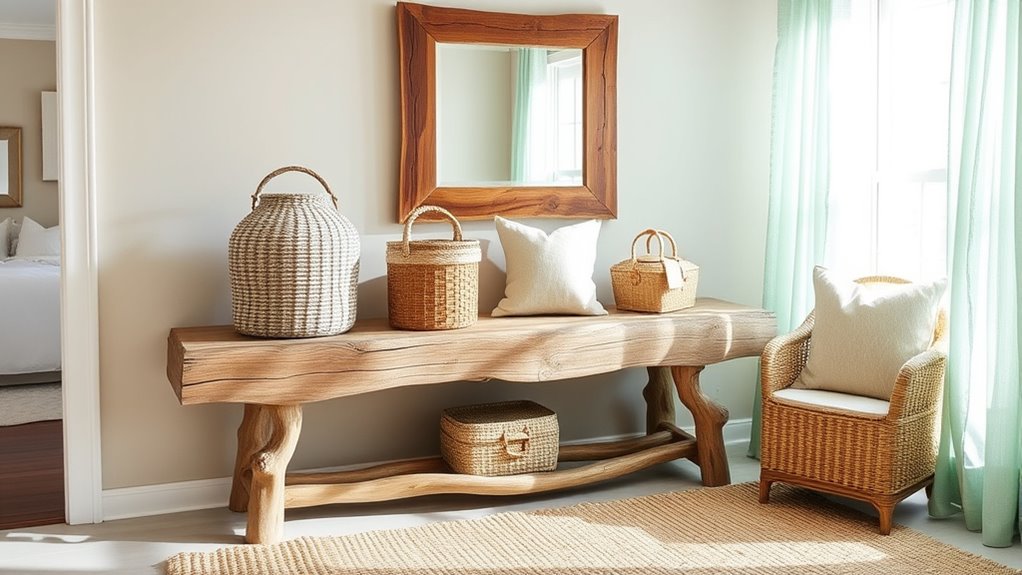
Natural textures like woven rattan, jute, and wicker instantly add warmth and tactile interest to your coastal space. Incorporate nautical decor elements such as driftwood and seashells to enhance the seaside vibe with organic details. Layering different textures, from linen curtains to sisal rugs, creates depth and sophistication that truly elevates your coastal interior. Additionally, selecting payment security measures for accent pieces can subtly support the overall healthfulness of your design. Embracing a growth mindset toward your decorating process can inspire you to experiment with new textures and ideas, making your space uniquely yours. Being mindful of interior design principles ensures your coastal décor remains balanced and inviting. Recognizing the importance of regional resources can also help you find authentic, locally-sourced materials that enrich your design.
Woven Natural Materials
Woven natural materials like rattan, wicker, seagrass, and bamboo bring essential texture and warmth to coastal interiors. These woven, natural textures create a relaxed, inviting atmosphere that embodies coastal style. Because they are often handcrafted and sustainably sourced, they add artisanal charm and eco-friendly appeal to your space. Incorporating woven textiles and accessories softens the overall look, adding visual interest through varied textures. Their open-weave structures reflect and diffuse sunlight, enhancing the light, airy feel typical of coastal decor. Using woven elements in furniture, rugs, baskets, and wall decor helps establish a cohesive, authentic seaside ambiance. Additionally, using unique and wicked planters made from natural materials further complements the coastal aesthetic while adding functional decor. These natural textures elevate your interior beyond simple color schemes, creating a tactile, vibrant coastal environment that’s both stylish and sustainable. Incorporating natural fibers into your decor enhances the authenticity and tactile richness of your space, making it even more inviting. For example, selecting appropriate vacuum cleaner attachments can help maintain the delicate woven surfaces without damage, ensuring they stay beautiful over time. Furthermore, integrating sound healing techniques that utilize natural vibrations can promote a calm and harmonious atmosphere within your coastal home. Incorporating these materials also promotes a sense of sustainability that aligns with eco-conscious coastal living.
Nautical Decor Elements
To truly capture the essence of seaside living, incorporating nautical decor elements with natural textures can transform your space into an authentic coastal retreat. Marine-inspired pieces like rope, nautical knots, and netting introduce subtle maritime motifs that elevate your decor. These nautical elements add visual interest and a sense of authenticity, creating a genuine seaside vibe. Complement them with weathered wood, driftwood, and seashells for tactile richness. Woven materials such as rattan, wicker, and sisal enhance the organic feel and add depth to your coastal design. Textured ceramics and fabrics further layer your space, fostering a relaxed, natural atmosphere. Additionally, understanding the importance of natural textures can help you craft a vibrant, tactile environment that embodies the true spirit of coastal living.
Layered Textural Depth
Layering different textures is key to creating a truly inviting coastal interior. This approach adds depth and tactile richness that elevate your space beyond simple décor. To achieve this, consider these natural textures:
- Incorporate textured wall treatments like grasscloth or faux bark wallpaper to create a nuanced background that enhances nautical accessories. Textural wall treatments can serve as a striking foundation for layered decor. Additionally, choosing wall treatments with natural fibers can further amplify the organic feel of your space. Exploring material diversity in your selections can help achieve a more layered and authentic look. Incorporating cybersecurity considerations, such as secure Wi-Fi and protected smart devices, can also help safeguard your digital environment in a coastal retreat.
- Use layered textures by pairing linen curtains with seagrass rugs or coral sculptures for visual depth and relaxed sophistication.
- Mix organic materials such as driftwood and shells with smooth ceramics or glass accents, providing subtle surface and color variations that enrich your design palette.
- Paying attention to texture variation allows for a more dynamic and authentic coastal aesthetic that feels both layered and harmonious. Additionally, varying the scale and roughness of textures introduces visual interest and prevents the design from feeling flat.
These layered textures, from rougher surfaces to sleek finishes, craft a balanced, multi-dimensional coastal aesthetic that feels both authentic and inviting.
Layering Patterns and Textiles for Depth and Interest
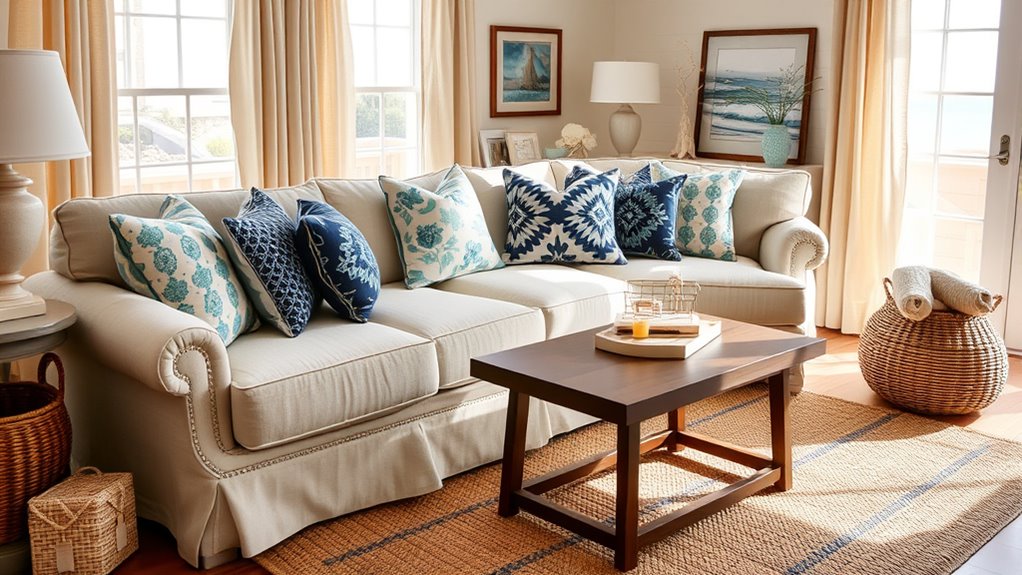
Adding depth and interest to coastal decor hinges on skillfully combining patterns and textiles. Layering textiles with different patterns—stripes, florals, geometrics—in shades of blue and grey creates visual depth and complexity. Mixing textured fabrics like linen, velvet, and woven materials enhances tactile interest while maintaining the relaxed seaside vibe. Using a variety of small-scale prints and larger motifs prevents visual overwhelm and adds dimension to your space. Incorporate layered textiles through rugs, throw pillows, and curtains to build a cohesive, inviting coastal atmosphere. Strategic placement of patterned textiles in various room areas creates a harmonious flow, emphasizing the layered, curated aesthetic that defines coastal decor. Additionally, understanding local business hours can help in scheduling visits to stores for selecting textiles and accessories, ensuring a smooth decorating process. This approach transforms an ordinary space into a lively, textured retreat.
Incorporating Nautical and Marine Motifs With Sophistication

Incorporating nautical and marine motifs with sophistication involves selecting refined materials and subtle designs that elevate maritime-inspired elements beyond casual decor. To achieve this, focus on quality finishes like brass or distressed wood, which add an upscale touch. Here are three ways to enhance your coastal design:
Elevate coastal decor with refined materials and subtle maritime motifs for a sophisticated seaside look.
- Use classic nautical patterns such as stripes or herringbone in muted tones to create visual interest without overpowering the space.
- Incorporate marine motifs like anchors or ship wheels in artwork, textiles, or accessories, keeping details minimal and elegant.
- Finish with glass lanterns, brass hardware, and polished driftwood pieces to add a timeless, refined appeal to your marine-inspired decor.
These strategies help you achieve a sophisticated coastal look that blends nautical motifs seamlessly into your home.
Balancing Bright and Moody Shades for a Harmonious Look

You can create a harmonious coastal space by pairing vibrant blues with neutral greys, which helps balance energy and calm. Using darker shades as a backdrop allows brighter colors to pop without overwhelming the room, adding depth through contrast. Layering different shades and textures enhances visual interest while maintaining a cohesive, serene atmosphere.
Pairing Vibrant With Neutral
Balancing vibrant shades with neutral tones is key to achieving a cohesive coastal look that feels both lively and soothing. When you layer vibrant hues like turquoise or cobalt with neutral tones such as greys or whites, you create a balanced, harmonious coastal style. Here are three ways to do it:
- Use neutral backgrounds—think light gray walls or beige textiles—to highlight vibrant shades without overwhelming the space.
- Incorporate layering of different shades and saturations of blue to add depth while maintaining a relaxed atmosphere.
- Pair bold, vibrant colors with muted, moody shades to prevent the space from feeling busy, keeping the focus on a calming, timeless aesthetic.
This approach guarantees your coastal decor remains versatile and inviting.
Creating Depth With Shadows
Layering shadows with moody shades like deep navy or charcoal can add rich depth to your coastal space, preventing bright colors from appearing flat or unoiled. By incorporating layered lighting—such as wall sconces or table lamps—you create shadow play that highlights textures and architectural details, balancing moody and bright tones. Strategically applying darker wall colors or accent pieces within your blue and white palette enhances spatial dimension through subtle shadow effects. Soft, diffused natural light combined with targeted artificial lighting helps generate nuanced shadows that add depth without overpowering your coastal elements. Textured fabrics and layered patterns further cast gentle shadows, enriching the overall harmony. This thoughtful interplay of light and shadow transforms your decor, making your space feel both lively and thoughtfully layered.
Achieving Balance Through Contrast
Achieving harmony in your coastal décor hinges on skillfully combining bright and moody shades to create a balanced, inviting space. Contrast is key—layering vibrant blues like turquoise with darker hues such as cobalt or misty grey adds depth and visual interest. To master this, consider these steps:
- Use subtle wall colors like light gray or muted blue to anchor bold patterns and accents, ensuring cohesion.
- Distribute bright and moody shades thoughtfully throughout the room to prevent overwhelm and maintain harmony.
- Incorporate darker shades alongside vibrant tones to deepen the space’s dimension without sacrificing freshness.
The Role of Natural Light and Architectural Elements
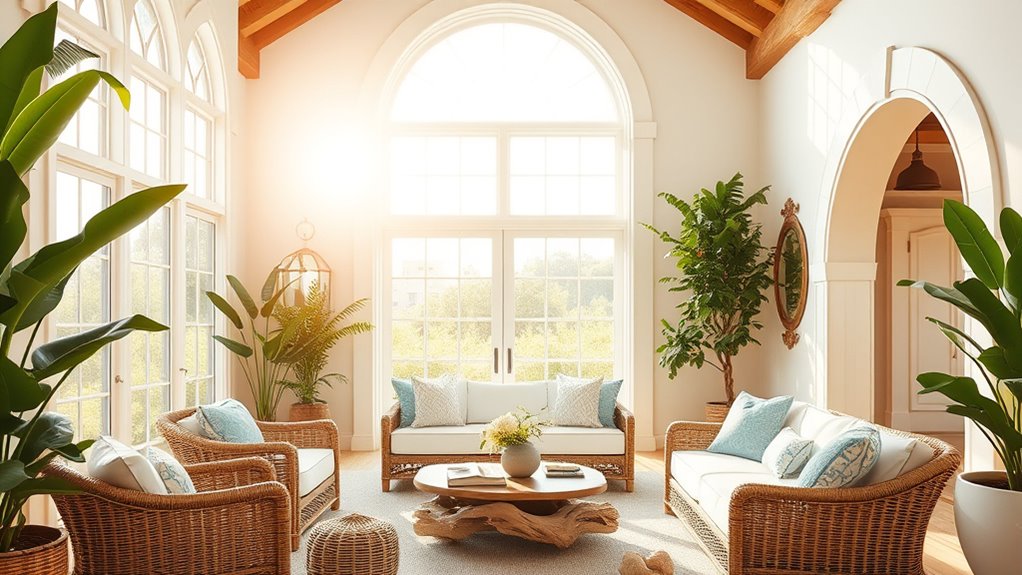
Natural light plays a vital role in enhancing coastal décor’s airy and open atmosphere. It floods your space, making it feel larger, brighter, and more inviting. Architectural features like large windows and glass doors are essential for maximizing sunlight and connecting indoor spaces with the outdoors. An open-plan layout promotes better light distribution and creates a seamless flow throughout your home. Skylights are an excellent addition, allowing sunlight to penetrate deeper into the interior, reducing the need for artificial lighting during the day. Light-colored walls and reflective surfaces further amplify natural light, enhancing the breezy, relaxed vibe typical of coastal interiors. By strategically incorporating these architectural elements, you create a luminous environment that embodies the fresh, airy spirit of coastal decor.
Selecting Furniture and Decor That Combine Functionality and Style
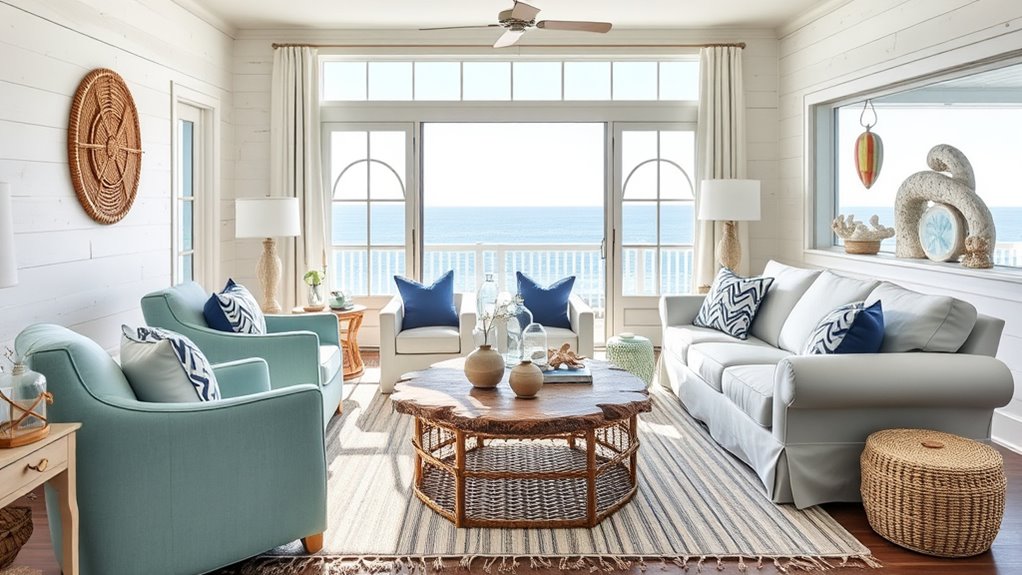
Selecting furniture and decor that blend function with style is key to creating a coastal space that feels both relaxed and effortless. To achieve this, focus on pieces that enhance your home’s laid-back vibe while serving practical purposes.
- Use furniture with natural textures like weathered wood or rattan for durability and style.
- Choose multi-functional items such as storage ottomans or sofa beds to maximize space without sacrificing comfort.
- Incorporate slipcovered or washable fabrics to keep your decor relaxed, easy to maintain, and beachy in feel.
Regional Influences Shaping Coastal and Beachy Styles
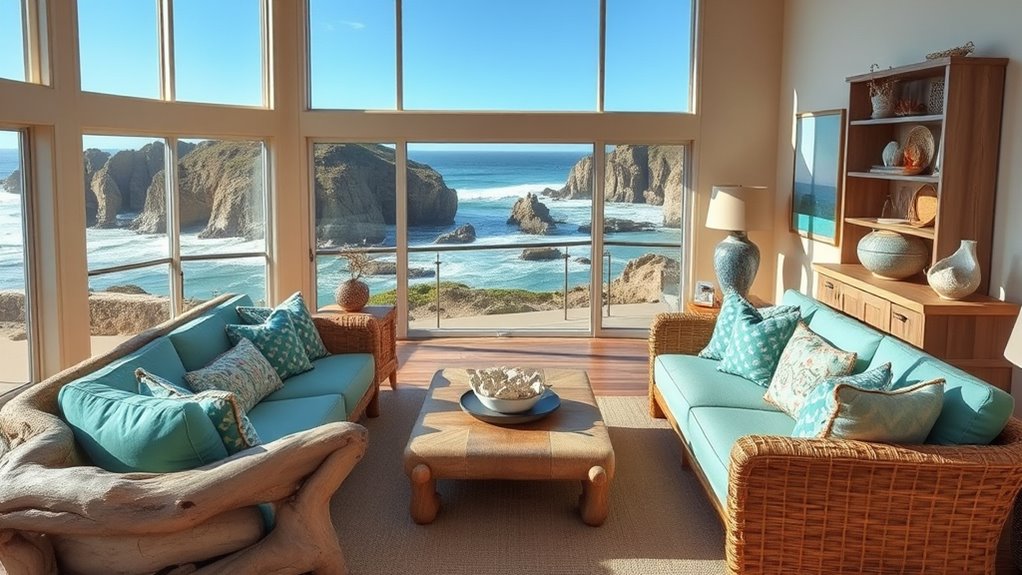
Regional influences play a significant role in shaping the distinct looks of coastal and beachy styles, reflecting the unique histories and environments of different areas. Coastal style often draws from regions like New England and Northern Europe, using weathered woods, nautical motifs, and muted color palettes inspired by these areas. In contrast, beachy style reflects tropical regions such as the Caribbean and Florida, emphasizing bright hues, lush greenery, and breezy textures. Architectural features like shiplap and seaside-inspired finishes further define regional styles. Nautical motifs—anchors, ropes, seashells—highlight maritime traditions. Your coastal decor can evoke specific regional atmospheres through these influences. Here’s a visual comparison:
| Region | Style Characteristics |
|---|---|
| Northern Europe | Weathered woods, muted color palette, nautical motifs |
| Caribbean & Florida | Bright colors, lush greenery, breezy textures |
| Coastal Architecture | Shiplap, seaside finishes, maritime accents |
Tips for Creating a Relaxed, Elegant Coastal Ambiance
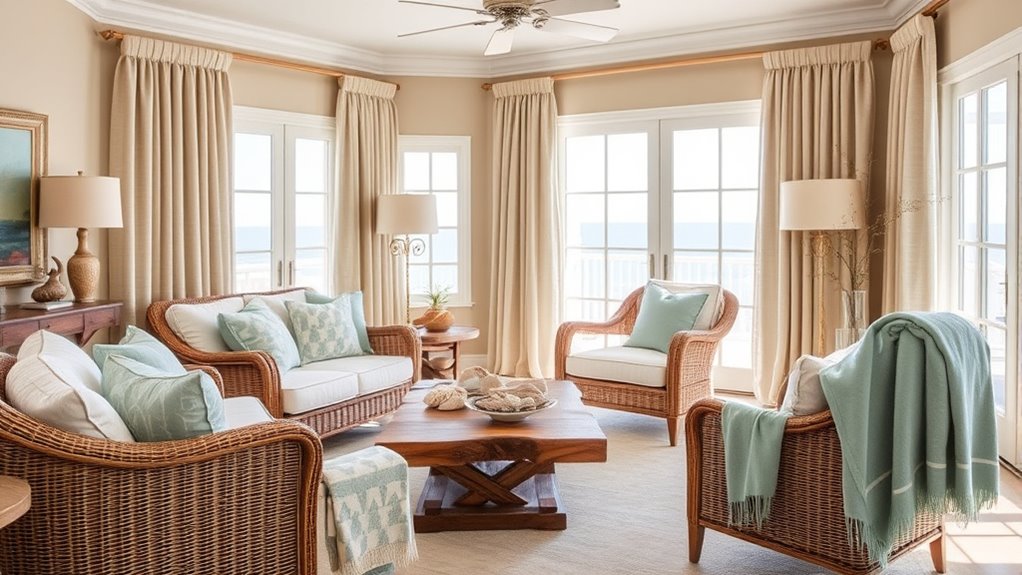
To create a relaxed yet elegant coastal ambiance, focus on layering textures and maintaining a sense of openness. Incorporate layered textures like linen, rattan, and weathered wood to add depth and sophistication to your coastal interior. Use a neutral palette of soft blues, neutrals, and subtle metallic accents to evoke elegance without losing the relaxed vibe. Select refined nautical-inspired accessories such as porcelain coral sculptures or antique brass fixtures to enhance coastal charm. Keep the layout uncluttered and airy by choosing minimal yet meaningful decor, emphasizing openness and tranquility. To maximize the luminous atmosphere, incorporate natural light and outdoor views. Here are some tips:
- Layer textures for depth and richness
- Stick to a neutral, soft color palette
- Use natural light and simple decor to enhance openness
Frequently Asked Questions
What Is the Difference Between Beachy and Coastal Decor?
You might wonder what sets beachy and coastal decor apart. Beachy decor is casual, playful, and bright, using whites, light blues, and weathered finishes to evoke a relaxed seaside vibe. Coastal decor, on the other hand, is more sophisticated, featuring muted tones, layered textures, and natural elements like driftwood. It creates a timeless elegance inspired by coastal regions, blending nautical motifs with refined finishes for a stylish, enduring look.
What Defines Coastal Decor?
You recognize coastal decor by its use of natural textures like weathered wood and seashells, combined with nautical motifs and a calming color palette inspired by the seaside. It creates a relaxed, airy atmosphere with plenty of natural light and outdoor views. You’ll notice soft neutrals like whites and blues, balanced with elegant details that make your space feel both casual and sophisticated, embodying the laid-back charm of the coast.
What Is the Difference Between Coastal and Nautical Decor?
You might think coastal and nautical decor are the same, but they’re worlds apart. Coastal decor immerses you in a relaxed, seaside vibe with soft hues and natural textures, while nautical decor screams maritime symbols like anchors and ships. It’s like choosing between a peaceful beach retreat and a bold sailor’s cabin. Understanding these differences helps you craft a space that truly captures the essence of seaside living, your way.
What Is the Difference Between Coastal and Farmhouse Decor?
You might wonder how coastal decor differs from farmhouse style. Coastal decor brings in seaside elements, nautical motifs, and a breezy, light-filled vibe with blues, whites, and sandy neutrals. Farmhouse decor, on the other hand, emphasizes rustic wood, vintage touches, and a cozy, inviting feel. While both are casual, coastal feels airy and nautical, and farmhouse exudes warmth with rustic charm and nostalgic country accents.
Conclusion
Embracing coastal décor means you’re not just chasing the blues, but creating an inviting escape that mirrors the calming rhythm of the sea. By thoughtfully blending colors, textures, and patterns, you craft a space that feels both relaxed and refined—like a gentle tide washing over your home. So, let your style ebb and flow, turning your space into a sanctuary where every detail whispers the timeless promise of the coast.
